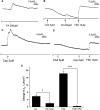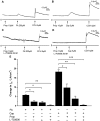Cellular mechanism underlying formaldehyde-stimulated Cl- secretion in rat airway epithelium
- PMID: 23372735
- PMCID: PMC3553115
- DOI: 10.1371/journal.pone.0054494
Cellular mechanism underlying formaldehyde-stimulated Cl- secretion in rat airway epithelium
Abstract
Background: Recent studies suggest that formaldehyde (FA) could be synthesized endogeneously and transient receptor potential (TRP) channel might be the sensor of FA. However, the physiological significance is still unclear.
Methodology/principal findings: The present study investigated the FA induced epithelial Cl(-) secretion by activation of TRPV-1 channel located in the nerve ending fiber. Exogenously applied FA induced an increase of I(SC) in intact rat trachea tissue but not in the primary cultured epithelial cells. Western blot and immunofluorescence analysis identified TRPV-1 expression in rat tracheal nerve ending. Capsazepine (CAZ), a TRPV-1 specific antagonist significantly blocked the I(SC) induced by FA. The TRPV-1 agonist capsaicin (Cap) induced an increase of I(SC), which was similar to the I(SC) induced by FA. L-703606, an NK-1 specific inhibitor and propranolol, an adrenalin β receptor inhibitor significantly abolished the I(SC) induced by FA or Cap. In the ion substitute analysis, FA could not induce I(SC) in the absence of extracelluar Cl(-). The I(SC) induced by FA could be blocked by the non-specific Cl(-) channel inhibitor DPC and the CFTR specific inhibitor CFTR(i-172), but not by the Ca(2+)-activated Cl(-) channel inhibitor DIDS. Furthermore, both forskolin, an agonist of adenylate cyclase (AC) and MDL-12330A, an antagonist of AC could block FA-induced I(SC).
Conclusion: Our results suggest that FA-induced epithelial I(SC) response is mediated by nerve, involving the activation of TRPV-1 and release of adrenalin as well as substance P.
Conflict of interest statement
Figures









Similar articles
-
Chloride channel function is linked to epithelium-dependent airway relaxation.Am J Physiol Lung Cell Mol Physiol. 2001 Feb;280(2):L334-41. doi: 10.1152/ajplung.2001.280.2.L334. Am J Physiol Lung Cell Mol Physiol. 2001. PMID: 11159013
-
Evidence for basolateral Cl- channels as modulators of apical Cl- secretion in pulmonary epithelia of Xenopus laevis.Am J Physiol Regul Integr Comp Physiol. 2011 Mar;300(3):R616-23. doi: 10.1152/ajpregu.00464.2010. Epub 2010 Dec 1. Am J Physiol Regul Integr Comp Physiol. 2011. PMID: 21123756
-
Bovine pancreatic duct cells express cAMP- and Ca(2+)-activated apical membrane Cl- conductances.Am J Physiol. 1997 Jul;273(1 Pt 1):G204-16. doi: 10.1152/ajpgi.1997.273.1.G204. Am J Physiol. 1997. PMID: 9252528
-
Naringenin Regulates CFTR Activation and Expression in Airway Epithelial Cells.Cell Physiol Biochem. 2017;44(3):1146-1160. doi: 10.1159/000485419. Epub 2017 Nov 27. Cell Physiol Biochem. 2017. PMID: 29179179
-
Evidence for basolateral but not apical membrane localization of outwardly rectifying depolarization-induced Cl(-) channel in airway epithelia.J Membr Biol. 2000 Aug 1;176(3):217-21. doi: 10.1007/s00232001091. J Membr Biol. 2000. PMID: 10931973
Cited by
-
Regulation of smooth muscle contractility by the epithelium in rat tracheas: role of prostaglandin E2 induced by the neurotransmitter acetylcholine.Ann Transl Med. 2021 Feb;9(4):313. doi: 10.21037/atm-20-5500. Ann Transl Med. 2021. PMID: 33708940 Free PMC article.
-
Simulation of Cl(-) Secretion in Epithelial Tissues: New Methodology Estimating Activity of Electro-Neutral Cl(-) Transporter.Front Physiol. 2015 Dec 23;6:370. doi: 10.3389/fphys.2015.00370. eCollection 2015. Front Physiol. 2015. PMID: 26779025 Free PMC article.
References
-
- Lino-Dos-Santos-Franco A, Domingos HV, Oliveira AP, Breithaupt-Faloppa AC, Peron JP, et al. (2010) Differential effects of formaldehyde exposure on the cell influx and vascular permeability in a rat model of allergic lung inflammation. Toxicol Lett 197: 211–218. - PubMed
-
- Persoz C, Achard S, Leleu C, Momas I, Seta N (2010) An in vitro model to evaluate the inflammatory response after gaseous formaldehyde exposure of lung epithelial cells. Toxicol Lett 195: 99–105. - PubMed
-
- National Toxicology Program (2010) Final Report on Carcinogens Background Document for Formaldehyde. Rep Carcinog Backgr Doc (10–5981): i–512. - PubMed
Publication types
MeSH terms
Substances
LinkOut - more resources
Full Text Sources
Other Literature Sources
Miscellaneous

